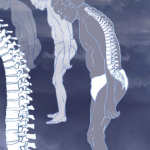CHICAGO—Axial spondylarthritis (SpA) is now the preferred name for a set of diseases including ankylosing spondylitis (AS), an inflammatory disease of the sacroiliac joints and spine. The term, reflecting the expanded diagnostic capabilities available today, emerged after the Assessment of Spondyloarthritis International Society (ASAS) established more inclusive classification criteria for inflammatory back pain (IBP) and SpA.
Diagnosis
The term axial spondylarthritis (or axial spondylarthropathy) is a more inclusive term in that it signifies that a reliable early diagnosis can now be made in the absence of X-ray changes. Magnetic resonance imaging (MRI) can detect sacroiliac inflammation before anything becomes evident on X-rays. This is important because the back pain and stiffness associated with SpA often begin in late adolescence to early adulthood, and patients tend to postpone reporting these symptoms to their physicians. One study has shown that one-third of those patients with early onset pain delay consulting a health care professional for more than 12 months after onset of symptoms, assuming that the symptoms will subside.1
In addition, early diagnosis is important because therapies that are more effective if used in the early stages of the disorder have become available. These include tumor necrosis factor (TNF) antagonists.
Another diagnostic tool is genetic testing. There is a genetic predisposition to axial spondylarthritis; studies show that at least one-quarter of patients have an underlying genetic risk for SpA.2 A positive genetic test for HLA-B27, a major disease predisposing gene, supports a clinician’s diagnosis of SpA in the absence of imaging findings.
This research and its application were addressed in the AHRP Concurrent Session entitled, “Axial Spondylarthritis: New Concepts,” at the 2011 ACR/ARHP Annual Scientific Meeting in November. [Editor’s note: This session was recorded and is available via ACR SessionSelect at www.rheumatology.org.] The session was presented by Muhammad Asim Khan, MD, professor of medicine at Case Western Reserve University School of Medicine and director of Spondylitis Clinic at MetroHealth Medical Center, both in Cleveland. Dr. Khan emphasized that using diagnostic tools and new classification criteria allows a primary care physician to screen potential SpA patients and refer them to a rheumatologist while the disease is still in its early stages.
Dr. Khan differentiated between mechanical pain and inflammatory back pain (IBP) when making a diagnosis. Mechanical back pain is often secondary to overuse of or injury to a normal spine and its supporting structures. On the other hand, IBP characteristics include:
- Insidious onset;
- Pain at night (with improvement upon rising);
- Age at onset less than 40 years;
- Improvement with exercise; and
- No improvement with rest.3
Dr. Khan stated that, “IBP is generally regarded as an important clinical symptom suggesting that the back pain a patient complains about is caused by axial spondyloarthitis. Indeed, about 33% of patients with IBP in primary care have subsequently been diagnosed as having SpA.” However, he warned that there are limitations to using IBP as a diagnostic sign: only approximately 80% of SpA patients versus about 20% of control groups (such as patients with mechanical back pain) also report the same symptoms. “This implies that the presence of IBP alone can never be sufficient to make a diagnosis of SpA but needs to be combined with other clinical, laboratory, and imaging parameters characteristic for SpA,” said Dr. Khan.
